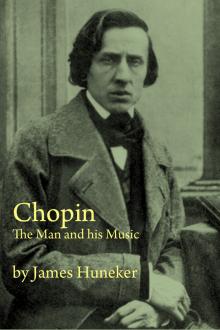Chopin: The Man and His Music, James Huneker [free e books to read online txt] 📗

- Author: James Huneker
- Performer: -
Book online «Chopin: The Man and His Music, James Huneker [free e books to read online txt] 📗». Author James Huneker
It was in these Preludes that Ignaz Moscheles first comprehended Chopin and his methods of execution. The German pianist had found his music harsh and dilettantish in modulation, but Chopin’s originality of performance—“he glides lightly over the keys in a fairylike way with his delicate fingers”—quite reconciled the elder man to this strange music.
To Liszt the Preludes seem modestly named, but “are not the less types of perfection in a mode created by himself, and stamped like all his other works with the high impress of his poetic genius. Written in the commencement of his career, they are characterized by a youthful vigor not to be found in some of his subsequent works, even when more elaborate, finished and richer in combinations; a vigor which is entirely lost in his latest productions, marked by an overexcited sensibility, a morbid irritability, and giving painful intimations of his own state of suffering and exhaustion.”
Liszt, as usual, erred on the sentimental side. Chopin, being essentially a man of moods, like many great men, and not necessarily feminine in this respect, cannot always be pinned down to any particular period. Several of the Preludes are very morbid—I purposely use this word—as is some of his early music, while he seems quite gay just before his death.
“The Preludes follow out no technical idea, are free creations on a small basis, and exhibit the musician in all his versatility,” says Louis Ehlert. “No work of Chopin’s portrays his inner organization so faithfully and completely. Much is embryonic. It is as though he turned the leaves of his fancy without completely reading any page. Still, one finds in them the thundering power of the Scherzi, the half satirical, half coquettish elegance of the Mazurkas, and the southern, luxuriously fragrant breath of the Nocturnes. Often it is as though they were small falling stars dissolved into tones as they fall.”
Jean Kleczynski, who is credited with understanding Chopin, himself a Pole and a pianist, thinks that “people have gone too far in seeking in the Preludes for traces of that misanthropy, of that weariness of life to which he was prey during his stay in the Island of Majorca…Very few of the Preludes present this character of ennui, and that which is the most marked, the second one, must have been written, according to Count Tarnowski, a long time before he went to Majorca. … What is there to say concerning the other Preludes, full of good humor and gaiety—No. 18, in E flat; No. 21, in B flat; No. 23, in F, or the last, in D minor? Is it not strong and energetic, concluding, as it does, with three cannon shots?”
Willeby in his “Frederic Francois Chopin” considers at length the Preludes. He agrees in the main with Niecks, that certain of these compositions were written at Valdemosa—Nos. 4, 6, 9, 13, 20 and 21—and that “Chopin, having sketches of others with him, completed the whole there, and published them under one opus number. … The atmosphere of those I have named is morbid and azotic; to them there clings a faint flavor of disease, a something which is overripe in its lusciousness and febrile in its passion. This in itself inclines me to believe they were written at the time named.”
This is all very well, but Chopin was faint and febrile in his music before he went to Majorca, and the plain facts adduced by Gutmann and Niecks cannot be passed over. Henry James, an old admirer of Madame Sand, admits her utter unreliability, and so we may look upon her evidence as romantic but by no means infallible. The case now stands: Chopin may have written a few of the Preludes at Majorca, filed them, finished them, but the majority of them were in his portfolio in 1837
and 1838. Op. 45, a separate Prelude in C sharp minor, was published in December, 1841. It was composed at Nohant in August of that year. It is dedicated to Mme. la Princesse Elizabeth Czernicheff, whose name, as Chopin confesses in a letter, he knows not how to spell.
IITheodore Kullak is curt and pedagogic in his preface to the Preludes.
He writes:
Chopin’s genius nowhere reveals itself more charmingly than within narrowly bounded musical forms. The Preludes are, in their aphoristic brevity, masterpieces of the first rank. Some of them appear like briefly sketched mood pictures related to the nocturne style, and offer no technical hindrance even to the less advanced player. I mean Nos. 4, 6, 7, 9, 15 and 20.
More difficult are Nos. 17, 25 and 11, without, however, demanding eminent virtuosity. The other Preludes belong to a species of character-etude. Despite their brevity of outline they are on a par with the great collections op. 10 and op.
25. In so far as it is practicable—special cases of individual endowments not being taken into consideration—I would propose the following order of succession: Begin with Nos. 1, 14, 10, 22, 23, 3 and 18. Very great bravura is demanded by Nos. 12, 8, 16 and 24. The difficulty of the other Preludes, Nos. 2, 5, 13, 19 and 21, lies in the delicate piano and legato technique, which, on account of the extended positions, leaps and double notes, presupposes a high degree of development.
This is eminently a common sense grouping. The first prelude, which, like the first etude, begins in C, has all the characteristics of an impromptu. We know the wonderful Bach Preludes, which grew out of a free improvisation to the collection of dance forms called a suite, and the preludes which precede his fugues. In the latter Bach sometimes exhibits all the objectivity of the study or toccata, and often wears his heart in full view. Chopin’s Preludes—the only preludes to be compared to Bach’s—are largely personal, subjective, and intimate.
This first one is not Bach-ian, yet it could have been written by no one but a devout Bach student. The pulsating, passionate, agitated, feverish, hasty qualities of the piece are modern; so is the changeful modulation. It is a beautiful composition, rising to no dramatic heights, but questioning and full of life. Klindworth writes in triplet groups, Kullak in quintolets. Breitkopf & Hartel do not. Dr. Hugo Riemann, who has edited a few of the Preludes, phrases the first bars thus:
Desperate and exasperating to the nerves is the second prelude in A minor. It is an asymmetric tune. Chopin seldom wrote ugly music, but is this not ugly, forlorn, despairing, almost grotesque, and discordant?
It indicates the deepest depression in its sluggish, snake-like progression. Willeby finds a resemblance to the theme of the first nocturne. And such a theme! The tonality is vague, beginning in E
minor. Chopin’s method of thematic parallelism is here very clear. A small figure is repeated in descending keys until hopeless gloom and depraved melancholy are reached in the closing chords. Chopin now is morbid, here are all his most antipathetic qualities. There is aversion to life—in this music he is a true lycanthrope. A self-induced hypnosis, a mental, an emotional atrophy are all present.
Kullak divides the accompaniment, difficult for small hands, between the two. Riemann detaches the eighth notes of the bass figures, as is his wont, for greater clearness. Like Klindworth, he accents heavily the final chords. He marks his metronome 50 to the half note. All the editions are lento with alla breve.
That the Preludes are a sheaf of moods, loosely held together by the rather vague title, is demonstrated by the third, in the key of G. The rippling, rain-like figure for the left hand is in the nature of a study. The melody is delicate in sentiment, Gallic in its esprit. A true salon piece, this prelude has no hint of artificiality. It is a precise antithesis to the mood of the previous one. Graceful and gay, the G major prelude is a fair reflex of Chopin’s sensitive and naturally buoyant nature. It requires a light hand and nimble fingers.
The melodic idea requires no special comment. Kullak phrases it differently from Riemann and Klindworth. The latter is the preferable.
Klindworth gives 72 to the half note as his metronomic marking, Riemann only 60—which is too slow—while Klindworth contents himself by marking a simple Vivace. Regarding the fingering one may say that all tastes are pleased in these three editions. Klindworth’s is the easiest. Riemann breaks up the phrase in the bass figure, but I cannot see the gain on the musical side.
Niecks truthfully calls the fourth prelude in E minor “a little poem, the exquisitely sweet, languid pensiveness of which defies description.
The composer seems to be absorbed in the narrow sphere of his ego, from which the wide, noisy world is for the time shut out.” Willeby finds this prelude to be “one of the most beautiful of these spontaneous sketches; for they are no more than sketches. The melody seems literally to wail, and reaches its greatest pitch of intensity at the stretto.” For Karasowski it is a “real gem, and alone would immortalize the name of Chopin as a poet.” It must have been this number that impelled Rubinstein to assert that the Preludes were the pearls of his works. In the Klindworth edition, fifth bar from the last, the editor has filled in the harmonies to the first six notes of the left hand, added thirds, which is not reprehensible, although uncalled for. Kullak makes some new dynamic markings and several enharmonic changes. He also gives as metronome 69 to the quarter. This tiny prelude contains wonderful music. The grave reiteration of the theme may have suggested to Peter Cornelius his song “Ein Ton.” Chopin expands a melodic unit, and one singularly pathetic. The whole is like some canvas by Rembrandt, Rembrandt who first dramatized the shadow in which a single motif is powerfully handled; some sombre effect of echoing light in the profound of a Dutch interior. For background Chopin has substituted his soul; no one in art, except Bach or Rembrandt, could paint as Chopin did in this composition. Its despair has the antique flavor, and there is a breadth, nobility and proud submission quite free from the tortured, whimpering complaint of the second prelude. The picture is small, but the subject looms large in meanings.
The fifth prelude in D is Chopin at his happiest. Its arabesque pattern conveys a most charming content; and there is a dewy freshness, a joy in life, that puts to flight much of the morbid tittle-tattle about Chopin’s sickly soul. The few bars of this prelude, so seldom heard in public, reveal musicianship of the highest order. The harmonic scheme is intricate; Klindworth phrases the first four bars so as to bring out the alternate B and B flat. It is Chopin spinning his finest, his most iridescent web.
The next prelude, the sixth, in B minor, is doleful, pessimistic. As George Sand says: “It precipitates the soul into frightful depression.”
It is the most frequently played—and oh! how meaninglessly—prelude of the set; this and the one in D flat. Classical is its repression of feeling, its pure contour. The echo effect is skilfully managed, monotony being artfully avoided. Klindworth rightfully slurs the duple group of eighths; Kullak tries for the same effect by different means.
The duality of the voices should be clearly expressed. The tempo, marked in both editions, lento assai, is fast. To be precise, Klindworth gives 66 to the quarter.
The plaintive little mazurka of two lines,





Comments (0)